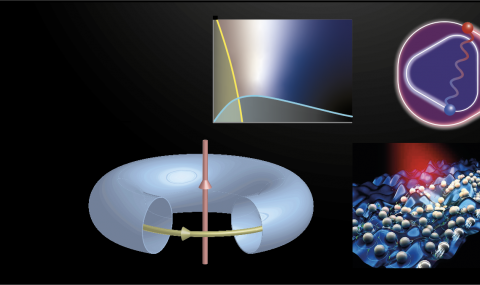Understanding the behavior of "strongly correlated" materials - such as cuprates, heavy fermion materials, and iron-based superconductors - remains one of the major outstanding challendges in condensed matter physics. These materials hold the key to high temperature superconductivity. They also seem to defy the basic paradigm of condensed matter physics that work so well in conventional insulators and metals, forming instead interaction-driven "Mott insulators" and non-Fermi liquid "strange metals".
An appealing idea is that much of this diverse physics can be understood by considering the properties of a quantum critical point, where the ground state of a metal of an insulator becomes unstable due to strong quantum fluctuations. The properties of the system near a quantum critical point are expected to be universal (i.e., independent of microscopic details), so one can hope to make progress on the basis of simple theoretical models that fall in the same "universality class" as the system of interest. Moreover, tuning the system to a quantum critical point is an effective method to destabilize the more conventional ground states and obtain new behaviors that can provide new insights into the physics of strong correlations. However, the theoretical problem of quantum criticality in metals is notoriously difficult, and many fundamental questions remain unanswered despite years of intense efforts and impressive progress on the topic.
We have taken a numerical approach to this problem. It turns out that many of the relevant theoretical models are free of the infamous "fermion sign problem", that prevents large-scale numerical simulations at low temperatures. Whether this lack of the sign problem follows from a deep physical reason, or just a stroke of good fortune, is not entirely clear - this is an interesting question by itself! Nevertheless, in recent years our group and others have been able to make significant progress in simulating metallic quantum criticality and using these simulations to understand the underlying physics.
In parallel, we have been working on the related problem of "strange metals" - metallic systems where the traditional Fermi liquid framework appears to break down. A common feature of many of these systems is a linear dependence of the electrical resistivity on temperature, with a nearly-universal "Planckian" slope - a behavior for which there is no accepted explanation to date. We have developed tractable models that can shed light on these problems, and have worked on modelling the behavior of strange metal behavior in specific experimental systems, that can provide valuable hints for the more general mechanisms at work.
Selected Publications:
- "Specific Heat of a Quantum Critical Metal", Ori Grossman, Johannes S. Hofmann, Tobias Holder, and Erez Berg, Phys. Rev. Lett. 127, 017601 (2021).
-
"Strongly coupled quantum phonon fluid in a solvable model", Evyatar Tulipman and Erez Berg, Phys. Rev. Research 2, 033431 (2020).
- "Theory of the strange metal Sr3Ru2O7", Connie H. Mousatov, Erez Berg, and Sean A. Hartnoll, PNAS 117 (6), 2852-2857 (2020).
- "Monte Carlo Studies of Quantum Critical Metals", Erez Berg, Samuel Lederer, Yoni Schattner, and Simon Trebst, Annual Review of Condensed Matter Physics 10, 63 (2019).
- "Translationally Invariant Non-Fermi-Liquid Metals with Critical Fermi Surfaces: Solvable Models", Debanjan Chowdhury, Yochai Werman, Erez Berg, and T. Senthil, Phys. Rev. X 8, 031024 (2018).
-
"Superconductivity mediated by quantum critical antiferromagnetic fluctuations: The rise and fall of hot spots", Xiaoyu Wang, Yoni Schattner, Erez Berg, and Rafael M. Fernandes, Phys. Rev. B 95, 174520 (2017).
-
“Non-quasiparticle transport and resistivity saturation: A view from the large-N limit,” Yochai Werman, Steven A. Kivelson, Erez Berg, npj Quantum Materials vol. 2, 7 (2017).
- "Superconductivity and non-Fermi liquid behavior near a nematic quantum critical point", Samuel Lederer, Yoni Schattner, Erez Berg, and Steven A. Kivelson, PNAS 114 (19) 4905-4910 (2017).
- "Competing Orders in a Nearly Antiferromagnetic Metal", Yoni Schattner, Max H. Gerlach, Simon Trebst, and Erez Berg, Phys. Rev. Lett. 117, 097002 (2016).
- "Sign-Problem–Free Quantum Monte Carlo of the Onset of Antiferromagnetism in Metals", Science, Vol 338, pp. 1606-1609 (2012).


